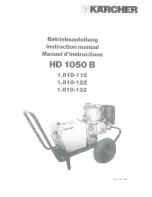
- 6 -
As weighing can be complicated, we suggest you estimate the
weight according to how full the drum is:
cotton and linen : drum full not too tighty packed
resistant synthetics : no more than 2/3 of the drum
delicate fabrics and wool : no more than 1/2 of the drum.
Before placing the laundry in the machine:
- mend all tears, holes and ladders;
- secure loose buttons and close poppers and zips;
- do not wash frayed garments - mend hems before washing;
- remove all small objects from pockets. Nails, pins, clips and
similar objects can seriously damage your washing machine
and laundry;
- remove curtain hooks;
- wash coloured garments and in particular those with non-fast
colours separately when washing for the first time. They are
likely to lose colour the first time they are washed;
- treat obstinate stains such as grass, rust, tar, paint, ink etc.
with a stain remover before washing.
To remove paint stains, for example, use a volatile substance
such as turpentine: in this case, you should wait for it to dry
completely before washing.
The manufacturer of your washing machine is not responsible
for any damage deriving from the use of volatile, inflammable
or toxic substances.
At the end of the washing
Damp laundry should be dried as soon as possible after
finishing the wash.
Knitwear and woollens should be dried flat away from direct
sunlight.
Detergents and additives
Good washing results also depend on the choice of detergent
and use of the correct quantities to avoid waste and protect the
environment. Although biodegradable, detergents contain subs-
tances which in large quantities can damage the delicate
ecological balance of nature.
Always use good quality detergents suitable for use in
washing machines.
Follow the indications given by the detergent manufacturer
according to the weight of laundry, the degree of soil and the
hardness of the water in your area; if you do not know how hard
it is, ask your local Water Authority.
Powder detergents.
The washing powder should be placed in the appropriate
compartments of the dispenser drawer before starting the
programme. Special detergents are availaible for coloured and
delicate fabrics and for wool.
"Concentrated" powder detergents
Pour the concentrated powder detergent into the main wash
( ) compartment.
Avoid selecting programmes including prewash when
concentrated detergents are used.
Liquid detergents
Using the new automatic dispenser for liquid detergents, it is
possible to use a liquid detergent for main wash phases.
Liquid detergents can be used instead of powder detergents
particularly for lightly soiled laundry and for medium or low
temperature washing programmes, while it is better to use a
powder detergent for high temperature washing
programmes.
Liquid additives
Any liquid additives for softening the laundry must be poured
into the compartment
of the detergent dispenser drawer
before starting the programme.
The addition of water softener is particularly useful when
drying the clothes in a tumble dryer after washing to avoid a
static charge.
Bleach
A bleach agent may be used on cotton programmes. However,
make sure that the fabric withstands the treatment. Bleach is
automatically washed down into the drum. Pour
1/4 to 1 glass of 12° chl bleach into compartment " " before
switching the machine on.
Make sure that the level of the liquid never exceeds the grid.
WASH CODE SYMBOLS
Strong wash
WASH
Delicate wash
Max. wash
Max. wash Max. wash
Max. wash
Hand
Do not
wash
BLEACHING
Bleach in cold water
Do not bleach
IRONING
Hot iron max.
200°C
Warm iron max.
150°C
Lukewarm iron
max. 110°C
Do not iron
DRY
CLEANING
Dry cleaning in
perchlorethylene petrol
Dry cleaning
Dry cleaning in
petrol, pure
Do not dry clean
DRYING
On the line
Flat
On clothes
hanger
Tumble dry
high temp.
low temp.
Do not
tumble dry


























